|
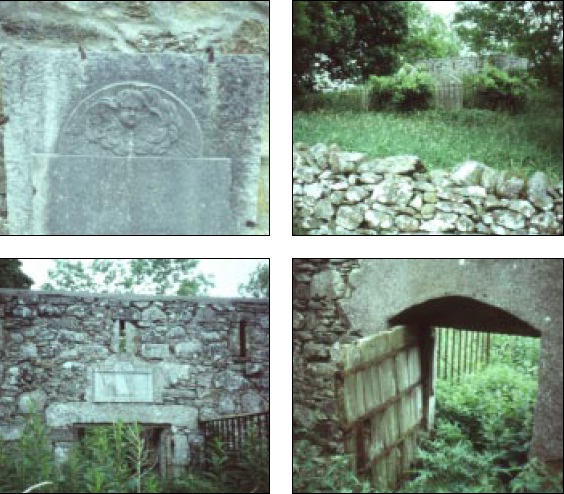 “The memory of great men is no less useful
than their presence.”
George, 4th Earl of Winton. “The memory of great men is no less useful
than their presence.”
George, 4th Earl of Winton.
The Seton of Meldrum at Belhelvie,
and Burial at St. Nathlan’s, the old Kirk of Bethelnie.
As with most historical documentation, it is kirk records which afford us most
of the information we have on medieval Belhelvie. The parson of Belhelvie became
a prebend of Aberdeen cathedral when Richard Pottocht appointed him as such in
1256.
This meant that a prebend’s manse
was built near the Bishop's Palace in Old Aberdeen, opposite the main entrance
to the churchyard where the principal of Aberdeen University is now housed. It
was built by George Seton, parson of Belhelvie, whose coat of arms was displayed
in the wall. His manse recorded as: "is in a great house, opposite to the
publick stile of St. Machar's church, and built by George Seton, parson of
Belhelvie; witnest his name, armorial-coat, three roses, and a crescent; and for
his crest, a cardinal's cap with its tresses yet to be seen...".
The old Kirk of Belhelvie, called
St. Nathlan's, still has boundary wall and gate piers : The enclosure is
situated a little to one side of a farm track and is bounded on four sides by a
rubble wall of field stones, some sections of which require to be built up. The
Old Kirk : Bethelnie was dedicated to St. Nathlan or St. Nechtan and was the old
parish kirk until it transferred to Meldrum in 1684.
Nothing now remains of the old kirk
within the disused kirkyard. Tombstones : It is impossible to state whether or
not there are any recumbent tombstones within the yard as it is completely
overgrown with weeds. There are two mid-19th - century wrought –iron enclosures
within the yard, both overgrown with ivy and their rails rusting.
There is the remains of the Meldrum
mausoleum, a square granite coursed rubble-built roofless enclosure with a
plaque above the entrance door stating “Beneath this building rests the remains
of many generations of Meldrums, Setons and Urquharts, from AD 1236 to 1863. The
door to the enclosure is completely rotten and needs to be replaced.
The floor of the mausoleum is filled
with debris. Interpretative Potential : Medium. The kirkyard is historically
interesting with regard to the Christian settlement of Meldrum and its
associations with three of the major families in the N.E.. The Meldrum enclosure
is certainly pre 18th -century in date. The view S. is spectacular. Access is
difficult as the site is located off the main Old Meldrum to Banff road and is
found by following a narrow country road up a hill. There is no actual parking
for cars.
The Seton's of
Mounie Castle Burials
The estate of the 2nd Seton's of
Mounie, is situated 3 miles north west of Oldmeldrum, Aberdeenshire, was again
in the hands of the Seton family from 1714 until 1970, when Mounie Castle was
sold and the family papers deposited in Aberdeen University Library.
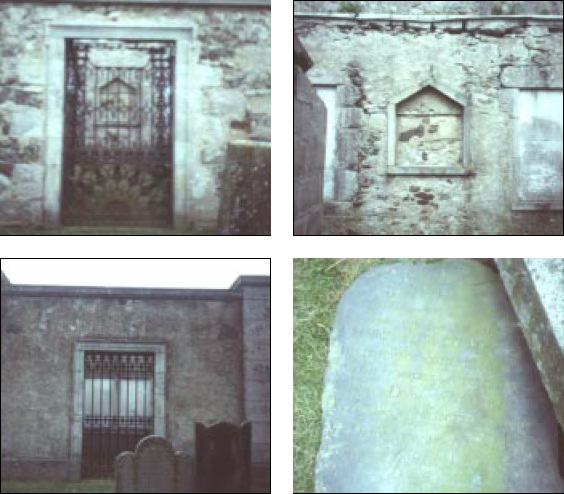 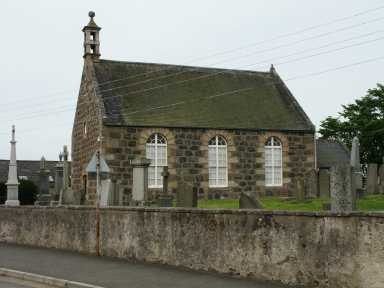 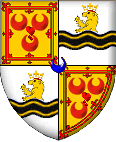 St.
Colm’s Kirk, Daviot Parish Kirkyard : St.
Colm’s Kirk, Daviot Parish Kirkyard :
The Boundary wall and gate piers are in a reasonable state of repair though the
entire boundary wall needs re-pointed and harled. The Old Kirk, with dated
lintel of 1789, built with dark granite walls and lighter coloured dressings, is
in good order throughout. The kirk is lit by three long round-arched windows on
the S. façade. There are a few missing slates on the S. flank of the roof.
Tombstones : There are approximately 33 recumbent tombstones, none of which are
decorated.
There are over one hundred upright
tombstones from the 18th - and 19th - centuries. There exists, a little to the
r.h.s. of the path, a small slate memorial to Mary Elisa Gordon who died on the
15 Dec. 1711. This small and charming memorial, with Latin inscription, nestles
to the side of another memorial and is unsecured.
The Neo-Classical Seton of Mounie
enclosure to the rear of the yard is in a reasonable state of repair though it
would benefit from being reharled, the weeds removed and the original gates
painted to preserve them. The Neo-Greek MacKenzie of Glack enclosure with good
acroteria corners is in a deplorable condition. The main white marble tablet is
broken and thrown to one side, though could be put back in its rightful
position. The two polished pink granite tombstones internally have been pushed
over and could be re-erected. The ridiculous lean-to built in a corner of the
enclosure should be removed as it is situated in a wholly unsuitably place. The
original gate must be painted to preserve it. The Shepherd memorial, to the rear
of the yard, is overgrown with ivy and elderflower and one side of the small
enclosure wall is collapsing. These weeds need to be removed and the enclosure
wall rebuilt.
All of the recumbent stones need to be brushed urgently and the grass should be
lifted when cut. The various enclosures listed above require a good deal of
attention as they are good examples of their type.
The Seton's of Pitmedden and Udny Burials
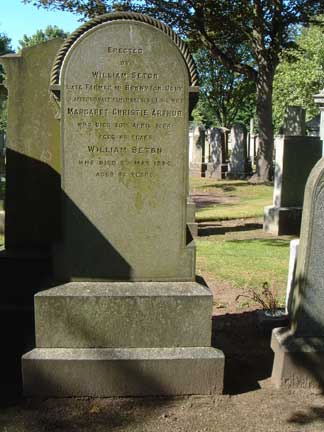 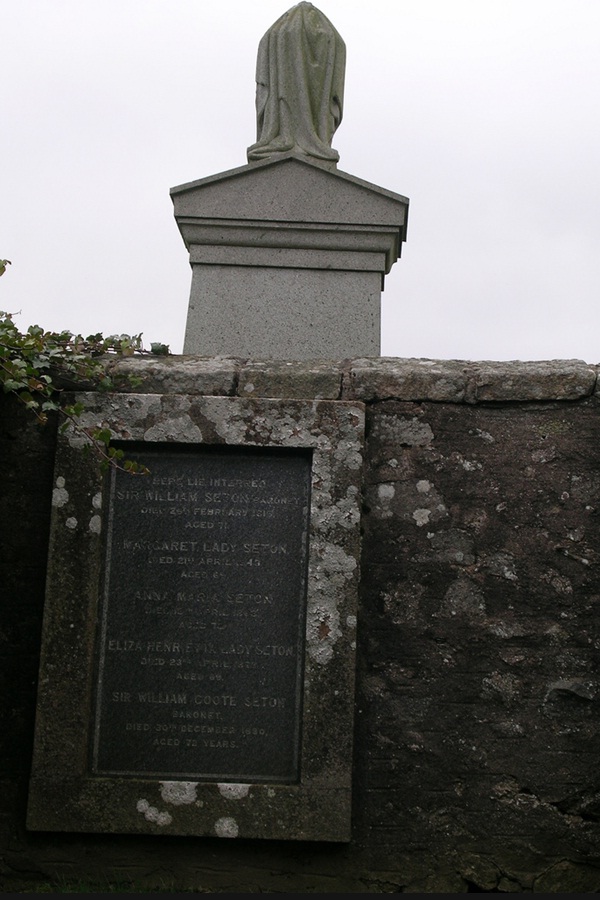 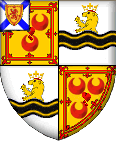 There
was a chapel of the Holy Trinity, commonly called Christ's
Kirk of Udny. The parish of Udny was erected and disjoined
from Ellon, Logie-Buchan, Tarves and Foveran on 19th
December 1597, and in 1605 a church of greater size was
built to replace Christ's Kirk. A new church built in 1821
was renovated in 1883 (Scott et al 1915-61). There
was a chapel of the Holy Trinity, commonly called Christ's
Kirk of Udny. The parish of Udny was erected and disjoined
from Ellon, Logie-Buchan, Tarves and Foveran on 19th
December 1597, and in 1605 a church of greater size was
built to replace Christ's Kirk. A new church built in 1821
was renovated in 1883 (Scott et al 1915-61).
All that remains of the church dedicated Christ's Kirk is a
small portion of the walls, now used as a vault (ONB 1868).
(The Ordnance Survey Name Book [ONB] may be referring here
to the 1605 church built to replace Christ's Kirk.)
Name Book 1868; H Scott et al 1915-61.
No trace of the church. There is no evidence of the early
building in the burial vaults. The burial ground has been
extended and is still in use.
Visited by OS (RL) 5 April 1972.
Nothing can be seen of this church and the burial ground in
which it stood remains in use.
Visited by RCAHMS (ATW, JRS), 29 January 1997.
| 
